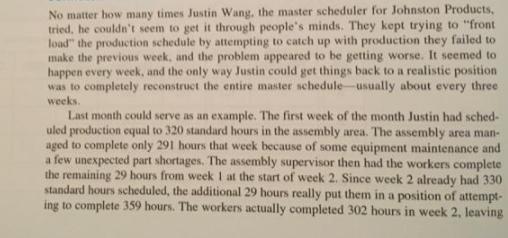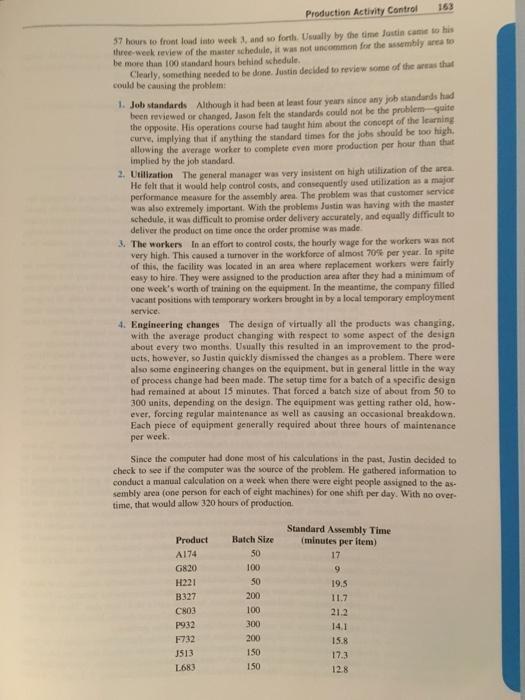Answered step by step
Verified Expert Solution
Question
1 Approved Answer
No matter how many times Justin Wang, the master scheduler for Johnston Products, tried, he couldn't seem to get it through people's minds. They



No matter how many times Justin Wang, the master scheduler for Johnston Products, tried, he couldn't seem to get it through people's minds. They kept trying to "front load" the production schedule by attempting to catch up with production they failed to make the previous week, and the problem appeared to be getting worse. It seemed to happen every week, and the only way Justin could get things back to a realistic position was to completely reconstruct the entire master schedule usually about every three weeks. Last month could serve as an example. The first week of the month Justin had sched- uled production cqual to 320 standard hours in the assembly area. The assembly area man- aged to complete only 291 hours that week because of some equipment maintenance and a few unexpected part shortages. The assembly supervisor then had the workers complete the remaining 29 hours from week I at the start of week 2. Since week 2 already had 330 standard hours scheduled, the additional 29 hours really put them in a position of attempt- ing to complete 359 hours. The workers actually completed 302 hours in week 2, leaving 163 Production Activity Control 37 hours to front load into week 3, and so forth. Usually by the time Jastin came to his three-week review of the master schedule, it was not uncommon for the assembly area lo be more than 100 standard hours behind schedule. Clearly, something needed to be done. Justin decided to review some of the areas that could be causing the problem: 1. Job standards Although it had been at least four years since any job standards had been reviewed or changed, Jason felt the standards could not be the problemquite the opposite. His operations course had taught him about the concept of the learning curve, implying that if anything the standard times for the jobs should be too high, allowing the average worker to complete even more production per hour than that implied by the joh standard. 2. Utilization The general manager was very insistent on high utilization of the area He felt that it would help control costs, and consequently used utilization as a major performance measure for the assembly area. The problem was that customer service was also extremely important. With the problems Justin was having with the master schedule, it was difficult to promise order delivery accurately, and equally difficult to deliver the on time once the order promise was made 3. The workers In an effort to control costs, the hourly wage for the workers was not very high. This caused a turnover in the workforce of almost 70% per year. ln spite of this, the facility was located in an area where replacement workers were fairly easy to hire. They were assigned to the production arca after they had a minimum of one week's worth of training on the equipment. In the meantime, the company filled vacant positions with temporary workers brought in by a local temporary employment service. 4. Engineering changes The design of virtually all the products was changing, with the average product changing with respect to some aspect of the design about every two months, Usually this resulted in an improvement to the prod- ucts, however, so Justin quickly dismissed the changes as a problem. There were also some engineering changes on the equipment, but in general little in the way of process change had been made. The setup time for a batch of a specific design had remained at about 15 minutes. That forced a batch size of about from 50 to 300 units, depending on the design. The equipment was getting rather old, how- ever, forcing regular maintenunce as well as causing an occasional breakdown. Each piece of equipment generally required about three hours of maintenance per week. Since the computer had done most of his calculations in the past, Justin decided to check to see if the computer was the source of the problem. He gathered iaformation to conduct a manual calculation on a week when there were eight people assigned to the as- sembly area (one person for each of eight machines) for one shift per day. With no over- time, that would allow 320 hours of production. Standard Assembly Time (minutes per item) Product Batch Size A174 50 17 G820 100 H221 50 19.5 B327 200 11.7 C803 100 21.2 P932 300 14.1 F732 200 15.8 J513 150 17.3 L683 150 12.8 164 CHAPTER SIX Assignment 1. With this information, Justin calculated the total standard time required to be within the 320 hours available. Is he correct? Calculate the time required and check the accu- racy of his calculation. 2. List the areas you think are causing trouble in this facility. 3. Develop a plan to deal with the situation and try to get the production schedule back under control under the constraints listed. No matter how many times Justin Wang, the master scheduler for Johnston Products, tried, he couldn't seem to get it through people's minds. They kept trying to "front load" the production schedule by attempting to catch up with production they failed to make the previous week, and the problem appeared to be getting worse. It seemed to happen every week, and the only way Justin could get things back to a realistic position was to completely reconstruct the entire master schedule usually about every three weeks. Last month could serve as an example. The first week of the month Justin had sched- uled production cqual to 320 standard hours in the assembly area. The assembly area man- aged to complete only 291 hours that week because of some equipment maintenance and a few unexpected part shortages. The assembly supervisor then had the workers complete the remaining 29 hours from week I at the start of week 2. Since week 2 already had 330 standard hours scheduled, the additional 29 hours really put them in a position of attempt- ing to complete 359 hours. The workers actually completed 302 hours in week 2, leaving 163 Production Activity Control 37 hours to front load into week 3, and so forth. Usually by the time Jastin came to his three-week review of the master schedule, it was not uncommon for the assembly area lo be more than 100 standard hours behind schedule. Clearly, something needed to be done. Justin decided to review some of the areas that could be causing the problem: 1. Job standards Although it had been at least four years since any job standards had been reviewed or changed, Jason felt the standards could not be the problemquite the opposite. His operations course had taught him about the concept of the learning curve, implying that if anything the standard times for the jobs should be too high, allowing the average worker to complete even more production per hour than that implied by the joh standard. 2. Utilization The general manager was very insistent on high utilization of the area He felt that it would help control costs, and consequently used utilization as a major performance measure for the assembly area. The problem was that customer service was also extremely important. With the problems Justin was having with the master schedule, it was difficult to promise order delivery accurately, and equally difficult to deliver the on time once the order promise was made 3. The workers In an effort to control costs, the hourly wage for the workers was not very high. This caused a turnover in the workforce of almost 70% per year. ln spite of this, the facility was located in an area where replacement workers were fairly easy to hire. They were assigned to the production arca after they had a minimum of one week's worth of training on the equipment. In the meantime, the company filled vacant positions with temporary workers brought in by a local temporary employment service. 4. Engineering changes The design of virtually all the products was changing, with the average product changing with respect to some aspect of the design about every two months, Usually this resulted in an improvement to the prod- ucts, however, so Justin quickly dismissed the changes as a problem. There were also some engineering changes on the equipment, but in general little in the way of process change had been made. The setup time for a batch of a specific design had remained at about 15 minutes. That forced a batch size of about from 50 to 300 units, depending on the design. The equipment was getting rather old, how- ever, forcing regular maintenunce as well as causing an occasional breakdown. Each piece of equipment generally required about three hours of maintenance per week. Since the computer had done most of his calculations in the past, Justin decided to check to see if the computer was the source of the problem. He gathered iaformation to conduct a manual calculation on a week when there were eight people assigned to the as- sembly area (one person for each of eight machines) for one shift per day. With no over- time, that would allow 320 hours of production. Standard Assembly Time (minutes per item) Product Batch Size A174 50 17 G820 100 H221 50 19.5 B327 200 11.7 C803 100 21.2 P932 300 14.1 F732 200 15.8 J513 150 17.3 L683 150 12.8 164 CHAPTER SIX Assignment 1. With this information, Justin calculated the total standard time required to be within the 320 hours available. Is he correct? Calculate the time required and check the accu- racy of his calculation. 2. List the areas you think are causing trouble in this facility. 3. Develop a plan to deal with the situation and try to get the production schedule back under control under the constraints listed.
Step by Step Solution
★★★★★
3.34 Rating (154 Votes )
There are 3 Steps involved in it
Step: 1
Answer 1 Frontloading is an issue in capacity planning because this leads to the addition of loads to the prefixed loading schedule As in this case co...
Get Instant Access to Expert-Tailored Solutions
See step-by-step solutions with expert insights and AI powered tools for academic success
Step: 2

Step: 3

Ace Your Homework with AI
Get the answers you need in no time with our AI-driven, step-by-step assistance
Get Started


